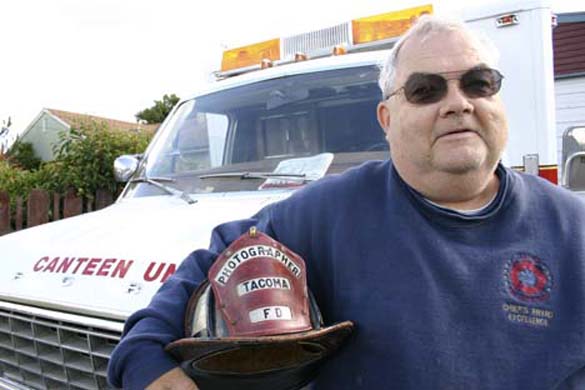One recent weekday afternoon, Ralph Decker was in the middle of describing a piece of Tacoma firefighting history when he was interrupted. A noisy din emanated from the bottom floor of the Tacoma home he shares with his wife, Michelle. A collection of beeps and crackles sprayed out of a scanner radio and filled the upstairs living room.
“That’s a false alarm,” said Michelle, who paused for several beats to pick up the noise’s subtle nuances. “It could be anything from equipment hitting a sprinkler head, a mouse chewing on wires, or someone smoking a cigarette under a smoke detector. If there were a bunch of tones and warbles before those three beeps, it would have been an actual fire.”
The Deckers are familiar with these noises. As so-called “Fire Buffs,” the pair monitors the radio to learn when to jump into action. In the garage, a retired ambulance has been converted into a mobile canteen unit — stocked with all the soup, energy drinks, fresh water, and other provisions a firefighter might need during a long shift. In the living room, stacks of photo albums depict Tacoma’s firefighting history, and line one end of a kitchen table. A book, 100 Years of Firefighting in the City of Destiny, co-written by Ralph and the late Clyde Talbot, sits on a coffee table.
Ralph, 65, has been drawn to the department for 50 years. It started when he was a teenage newspaper courier. One stop on his route was a former fire station located downtown at South Ninth and A Streets. His interest continued over 31 years at Weyerhaeuser, where he worked the graveyard shift as a computer operator; Decker’s bosses were willing to rearrange his schedule so he could follow firefighters on big calls.
Since 1971, he has served as the official photographer for the department, and has provided photographs of fire scenes that have been used in criminal court cases that involve arsons. Recently, he received the Murray Morgan Award from the Tacoma Historical Society.
Michelle, 48, is equally enthusiastic. The pair works side-by-side when listening to the scanner and cooking up meals at fire scenes.
According to the International Fire Buff Associates, which was created in 1953 and is headquartered in Mequon, Wisc., there are approximately 5,000 official fire buffs in the United States who provide services ranging from full-fledge canteen operations similar to the Deckers’, to casual enthusiasts who have an interest in firefighting history and want to support their local engine companies. Annually, members of the organization’s nine regions meet for a convention (Tacoma was host in 1999).
In Tacoma, four canteen units cover the city: Canteen One (Ralph and Michelle); Canteen Two (Northeast Tacoma); Canteen Three (Central Tacoma); and Canteen Four (Hilltop).
The Tacoma Daily Index caught up with the Deckers to learn more about Tacoma Fire Buffs, their service to firefighters, and their interest in Tacoma’s firefighter history.
TACOMA DAILY INDEX: How would you define the term ‘Fire Buff?’
RALPH DECKER: A fire buff is a person who has a real interest in the fire department, but is not necessarily a firefighter. Most fire buffs, their normal vocation is not in the fire service at all. I worked at Weyerhaeuser for 31 years. It was completely unrelated to the fire department. This is a hobby. We have the International Fire Buff Associates, which pretty much started in World War II, when a lot of the firefighters were being called up and drafted for the war effort. They had to have auxiliary firefighters. Back then, firefighters didn’t have the training that they do today. Once the war effort was over and people were coming back to their regular fire department jobs, auxiliary guys said, ‘We don’t want to quit.’ So they formed this club. Most major cities had a Fire Buff club. They would go to fires just like we do. Originally, it was called a coffee wagon. In 1952, the Fire Buffs knew about each other, and decided to have a big meeting with all these clubs to officially organize the International Fire Buff Associates. Right now, there are over 50 clubs around the country. We have a convention every year. Last year, it was in Boston, and I went to it and had a great time. It was so much fun to be able to sit down and talk to them about what kind of fires they had that year, what kind of new equipment was out there. Most people think if you see one fire engine, you’ve seen them all. That’s not true. It’s really a neat hobby.
TACOMA DAILY INDEX: How did Tacoma Fire Buffs form in Tacoma?
MICHELLE DECKER: We saw the need for refreshments for firefighters and fire victims at fire scenes. I started providing this service out of the back of my Chevy Luv pick-up truck. As things evolved, we formed a club that became official in 1987. In 1995, former fire chief Dick Moore donated a Ford Marion ambulance. We had been talking to them possibly about the donation of a rig that could be used as a mobile kitchen or canteen unit. We had it painted and added decals. On their own time, the fire department shop installed several pieces of donated equipment: propane stove, microwave, and small refrigerator. Then the firefighters came onboard with voluntary payroll deduction donations through Local 31. That pays for the fuel, some of the maintenance on the rig, supplies, equipment, and our insurance needs. We’re right now saving toward the purchase of a new rig. We’re looking for something that would allow exterior access directly to restroom facilities for the firefighters.
INDEX: How do you know when an emergency is serious enough to respond to, and you need to assist firefighters?
MICHELLE DECKER: We’re self-dispatched. We have a radio here, and we monitor it 24/7. When firefighters dispatch to a fire, we listen. There are certain clues that a knowledgeable person can pick up. Is it actually burning? Is it a pre-fire from the Fourth of July? Or is it a fully engulfed building? One of the clues is the dispatcher — is it their normal voice, or is it up 10 octaves? Are they speaking calmly, or are they shooting everything out as fast as they can? We’ve responded to a number of incidents. Several years ago, there was a flood at apartments near South Hosmer. They called us in to serve hot soup. There were a couple senior citizens who we had in the cab of our rig, to keep warm and dry while we were serving hot food out of the back end of the rig. Another time, up on Marine View Drive, there was a fire that burned for two weeks. When the initial fire came in, we actually self-responded on that one, went up to the top, and met face-to-face with the chief. We set up right there at the top, and had another one of the units set up down below with cold refreshments for the firefighters responding on Marine View Drive.
RALPH DECKER: The one thing we do not respond to on our own is a hazardous materials incident, or an unusual event — like the shooting at Tacoma Mall. In those instances, we’ll wait until we are called because they do not need anybody unannounced coming in like that. During the Tacoma Mall shooting, firefighters called us.
INDEX: How many calls do you respond to in a given week or month?
MICHELLE DECKER: I think we are averaging about 58 calls per year.
RALPH DECKER: I think it’s more than that. It varies. Sometimes we respond two or three times per day. It’s just so variable.
INDEX: How did you become specifically interested in the Tacoma Fire Department?
RALPH DECKER: It started for me when I was in high school. I graduated from Stadium High School in 1961. Three or four years prior to that, I had a paper route in downtown Tacoma. I had the best route in the city. One of my customers was Engine No. 6 at Ninth and A Street. Of course, I got to know all the firefighters on duty. There were three platoons at that time, and I got to know all of them. I used to spend a half-hour per day at the station. They pulled every trick that they would pull on a rookie firefighter on me. None of them were meant to hurt me. They were just practical jokes. One time, they tied me in a chair and pulled me up in the hose tower. Stuff like that. At that time, in the 1960s, there was a height requirement. A minimum of 5′ 8″. I’m 5′ 6″. I knew there was no way I could be a firefighter. I figured if the Lord wanted me to be a firefighter, I would have met the qualifications. I didn’t go to many fires because I didn’t have a radio at that time. I joined the Coast Guard right out of high school, and then went to work for Weyerhaeuser in 1966 as a computer operator. When I had money, I bought a scanner and photo equipment, and went out and shot pictures of fires. I bought a Super 8 movie camera, and a 35 millimeter. I would shoot movies of fires, and pictures of fire equipment and fire stations. The chief at that time made me the official photographer and historian for the department. I wasn’t paid. It was strictly volunteer.
INDEX: Why did you decide to co-write a book about the fire department?
RALPH DECKER: Being a photographer, you see pictures of the stations and their old rigs — early horse-drawn steamers, and then the first motorized rigs. They are fascinating pictures. At the time, there was a retired Tacoma firefighter, Clyde Talbot, who was working on a history of the department. He heard about me, I heard about him, and we finally met. We clicked. I took us eight years to compile the history of the department. The department didn’t keep very good records until 1911. The annual reports had very little information. Clyde was going through all the newspaper archives one page at a time looking for any articles written about the Tacoma Fire Department. On Friday afternoons, I would go down with my typewriter. He would have everything all marked off, and I would type it. Clyde did a lot more research than I did. He was sharp as a tack.










